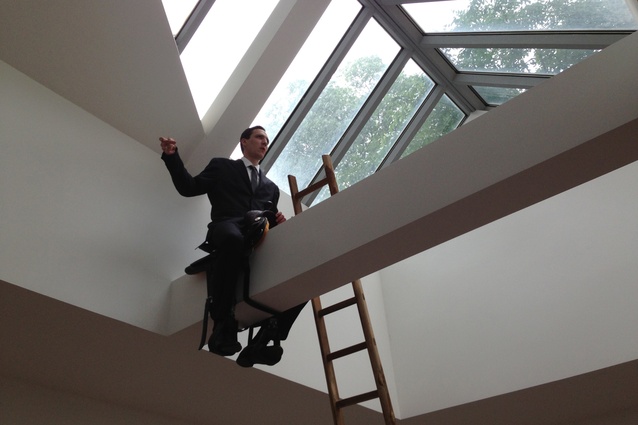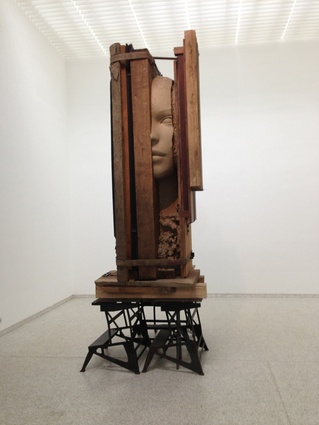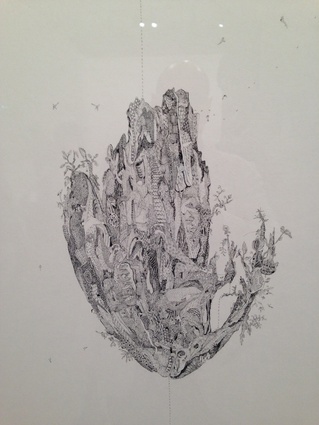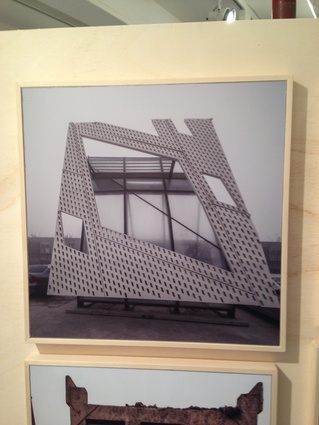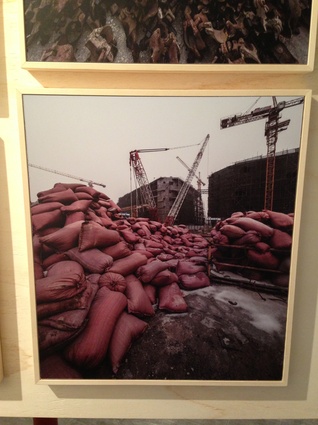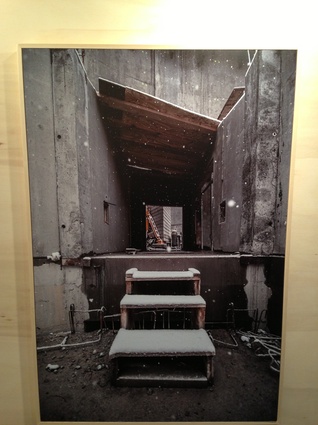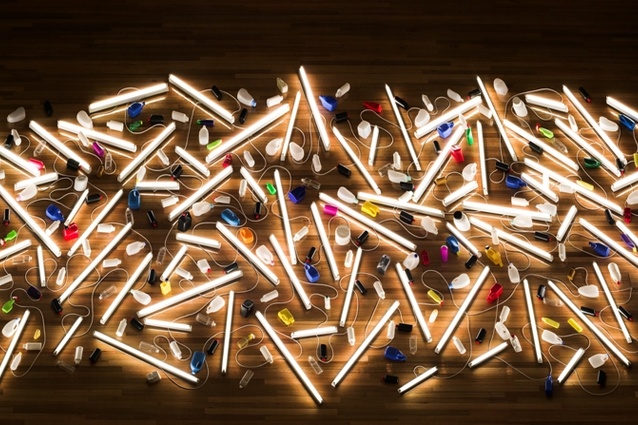Art (and Architecture) in Venice
Andrew Patterson discovers the numerous architectural ‘moments’ at the recent Venice Art Biennale – from miniature model houses to an Avatar-esque floating world to an iPad installation dedicated to Chinese shrines at risk from development.
Exploring the Venice Art Biennale in June, I couldn’t help wondering if the year-on/year-off art and architecture biennales might morph into a combined event. It would probably all make sense because this year’s 55th art biennale contains so much architecture, in parallel with recent architecture biennales exhibiting a good deal of ‘art’. Indeed, it seems these days the blurring of art and architecture is a zeitgeist; artists increasingly play with architectural themes and around one in 20 of the ‘art’ exhibitors are architects. The merging of the biennales might actually give New Zealand architects an opportunity to contribute within an international showcase. Plans are afoot, via the NZIA, for a presence at the architectural event, although whether official funding is provided remains to be seen.
I guess the big question is – why bother? Well, La Biennale di Venezia, the festival’s official name, began in 1895 and it is arguably the highlight of the international cultural calendar. It’s the place where ideas are thrown together into one city-sized pot, using the world’s most talented artists one year and architects the next year, all in tandem with various Venetian festivals for film, theatre and now dance. While there are some critics of the event, for the spectator, it is the kaleidoscope of tastes from across the world and the exploration of interesting, often incomprehensible and sometimes shattering ideas that makes it all worthwhile. It doesn’t matter whether you ‘get’ the artworks or become bedazzled by the intensity of it all, like an individual work or loathe it, there is always something new or someone to keep you moving on to the next.
What is interestingly different is that the Venice Biennale isn’t about ‘selling’ artworks in the way of the big art fairs, neither is it about the ‘awards’ and ‘sponsors’ focus you expect from an architecture festival. Rather, it’s about artists representing countries, galleries and institutions attempting to make us think and, if you wanted to be cynical, competing to outdo each other with their inherent genius.
A group of us rented a palazzo and joined the throngs of artists, patrons, collectors and curators (there are few tourists in Venice during opening week) and, within a day, we all found ourselves breaking out in bad cases of blisters and art-speak.
New Zealand’s biennale offering, Bill Culbert, is doing us proud with his Front door out back exhibition. The cleanness of Pacific Flotsam’s fluorescent light tubes strewn among everyday plastic objects set in front of a glistening Adriatic canal. Viscerally familiar, connected, universal and civilised, it is located in the Istituto S. M. della Pietà, a prominent site beside the lagoon on the Riva degli Schiavoni with one of the highest pedestrian counts in Venice.

New Zealand’s effort was well supported with 108 generous patrons, which, hearteningly, was way more than the Aussies gathered. It was also great to see New Zealand represented more than once in Venice. In the Time, Space and Existence collateral exhibition in the Palazzo Bembo, Christchurch artist Darryn George’s ‘Folder Room’ is an interior, a space of mystery. Dunedin-based conceptual artist Scott Eady references the sculpture of past exhibitors, including Carl Andre, playing on a history of antagonism between audiences and minimalist sculpture. Aucklander Mark Harvey was invited to participate in the Maldives Pavilion and Berlin-based Kiwi artist and rising star Simon Denny is showing alongside an illustrious group of international artists in the primary exhibition called The Encyclopaedic Palace.
Meanwhile, the festival’s rich assembly of architecturally related works have many highlights. Near Denny’s work, Chinese artist Kan Xuan’s linear iPad installation shows film footage of 500 religious shrines in China, gone or at risk because of development. For me, the Chinese were complete stars of the city. Within the Transfiguration exhibition, Wang Qingsong’s staged, large-format photographs explore his concerns for the future of Chinese society, particularly the people’s total devotion to achievement. The work has a similar aesthetic to that of Andreas Gursky but, in the context of China, it is ironic and revealing. Another highlight is reclusive artist Lin Xue’s Avatar-like floating buildings. These are inspirational in their intricate technique and scale: the artist’s dream for his imagined natural worlds being to “draw a landscape that one cannot finish looking at”.

A poignant artwork is a room filled with perfectly ordinary architectural models, entitled 387 Houses of Peter Fritz (1916–1992) Insurance Clerk from Vienna. They had been found in a sale of attic junk and traced to be the handiwork of one Peter Fritz. During retirement, Fritz had lovingly reconstructed often-bland everyday buildings from his locality in miniature. They contain a kind of radical contentment with the mundanity of the built environment and one of those shattering moments for your architect commentator.
At Construction Ahead, one of two collateral events devoted to pure architecture, architect Zhengfei Wang shows evocative, almost romantic, photographs of large-scale construction within the Cultural Centre of Jinan city. It refers to the economic, social and urban implications that these gigantic buildings hold for contemporary China while messaging that any architecture is a performance art.
At Vadim Zakharov’s performance piece Danaë, in the Russian Pavilion, a large, slowly eroding pile of gold coins is surrounded by an altar of red cushions provided for viewers to kneel on for worship. A linking conveyor belt system discovered high in the ceiling replenishes the coins in an endlessly absurd cycle.

An installation, elegant in its materiality, by Mark Manders is like a furnished interior of the brain. Within sandwiches of steel, timber and clay, a human face is present, seen and unseen from different viewpoints. In the Romanian Pavilion, a small group of performers restaged dozens of artworks from the previous 54 Biennales using their bodies as objects. It was a hit: an economical, simple and engaging response.

In the Polish exhibition (earplugs free at the door), artist Konrad Smolenski created a sound installation, Everything Was Forever, Until It Was No More, which draws on the illusory nature of time as explored by theoretical physicist Julian Barbour. Integrated into the architecture of the pavilion are two giant iron church bells backed by electronic sound walls, creating magnificent banks of pure tone that swallow you up. The ringing of the bells was synthesised into deafening waves of almost visual sound, transforming my whole body into a single ear. Wow!
As you might expect, visiting the British Pavilion provided rewards. English Magic is artist Jeremy Deller’s interconnected collection of imagery from popular culture and folklore, past, present and imagined future, offering up a taste of the ‘real’ England – the aspects typically buried deep and served up with a real cup of tea. Within the collection is a Peter Cairns photograph of artist Sarah Tynan’s painting, A good day for cyclists, of a hen harrier, one of the UK’s rarest birds, clutching a red Range Rover as prey. It refers to a situation in 2007 whereby a wildlife officer and two members of the public saw a pair of hen harriers being shot out of the sky as they flew over Sandringham Estate. The only people known to be shooting that day were Prince Harry and a friend. Strangely, the carcasses of the birds couldn’t be found: case closed.
In one of the hippest tickets of the collateral events, Rem Koolhaas makes an early appearance before his curatorship of next year’s architecture biennale, working in dialogue with Thomas Demand and curator Germano Celant. When Attitudes Become Form: Bern 1969/Venice 2013 is a re-enactment of the 1969 exhibition Live in Your Head. When Attitudes Become Form by Harald Szeemann, a famous pivotal point in art history. In 1969 in Kunsthalle, Bern, young revolutionary artists, including Joseph Beuys, explored a new approach to art and architecture, a liberating and interactive process that brought the disciplines together though installational art, arguably aiming at that zeitgeist of today.
There were many more architectural moments – too many to mention. Architect John Pawson created a crystal lens that harnessed the Vitruvian energy of Palladio’s renaissance building, for example, and the ‘big guns of the artworld’ were also in force: Richard Serra’s two-part sculpture, titled Pasolini (after the Italian film director), was beautifully paired with Belgian artist Thierry De Cordier’s darkly solid seascape paintings. I was very keen to see Ai Weiwei’s three projects on show but ended up avoiding the works due to the heaving crowds surrounding them. You certainly can’t expect to see everything at the art biennale, let alone take it all in, but it certainly is an unforgettable and architectural experience.
La Biennale di Venezia runs until 24 November.


